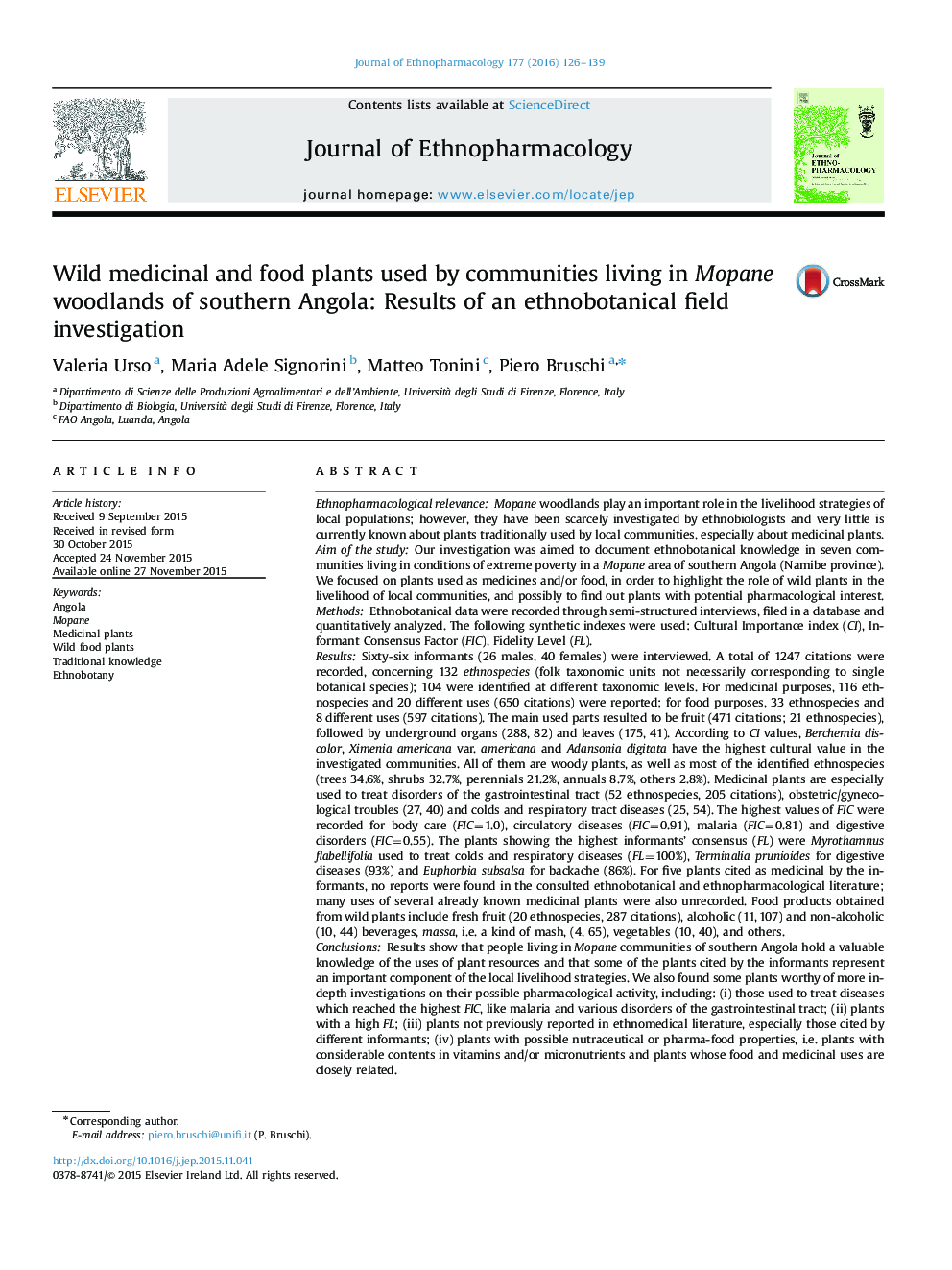| کد مقاله | کد نشریه | سال انتشار | مقاله انگلیسی | نسخه تمام متن |
|---|---|---|---|---|
| 5835387 | 1560385 | 2016 | 14 صفحه PDF | دانلود رایگان |
Ethnopharmacological relevanceMopane woodlands play an important role in the livelihood strategies of local populations; however, they have been scarcely investigated by ethnobiologists and very little is currently known about plants traditionally used by local communities, especially about medicinal plants.Aim of the studyOur investigation was aimed to document ethnobotanical knowledge in seven communities living in conditions of extreme poverty in a Mopane area of southern Angola (Namibe province). We focused on plants used as medicines and/or food, in order to highlight the role of wild plants in the livelihood of local communities, and possibly to find out plants with potential pharmacological interest.MethodsEthnobotanical data were recorded through semi-structured interviews, filed in a database and quantitatively analyzed. The following synthetic indexes were used: Cultural Importance index (CI), Informant Consensus Factor (FIC), Fidelity Level (FL).ResultsSixty-six informants (26 males, 40 females) were interviewed. A total of 1247 citations were recorded, concerning 132 ethnospecies (folk taxonomic units not necessarily corresponding to single botanical species); 104 were identified at different taxonomic levels. For medicinal purposes, 116 ethnospecies and 20 different uses (650 citations) were reported; for food purposes, 33 ethnospecies and 8 different uses (597 citations). The main used parts resulted to be fruit (471 citations; 21 ethnospecies), followed by underground organs (288, 82) and leaves (175, 41). According to CI values, Berchemia discolor, Ximenia americana var. americana and Adansonia digitata have the highest cultural value in the investigated communities. All of them are woody plants, as well as most of the identified ethnospecies (trees 34.6%, shrubs 32.7%, perennials 21.2%, annuals 8.7%, others 2.8%). Medicinal plants are especially used to treat disorders of the gastrointestinal tract (52 ethnospecies, 205 citations), obstetric/gynecological troubles (27, 40) and colds and respiratory tract diseases (25, 54). The highest values of FIC were recorded for body care (FIC=1.0), circulatory diseases (FIC=0.91), malaria (FIC=0.81) and digestive disorders (FIC=0.55). The plants showing the highest informants' consensus (FL) were Myrothamnus flabellifolia used to treat colds and respiratory diseases (FL=100%), Terminalia prunioides for digestive diseases (93%) and Euphorbia subsalsa for backache (86%). For five plants cited as medicinal by the informants, no reports were found in the consulted ethnobotanical and ethnopharmacological literature; many uses of several already known medicinal plants were also unrecorded. Food products obtained from wild plants include fresh fruit (20 ethnospecies, 287 citations), alcoholic (11, 107) and non-alcoholic (10, 44) beverages, massa, i.e. a kind of mash, (4, 65), vegetables (10, 40), and others.ConclusionsResults show that people living in Mopane communities of southern Angola hold a valuable knowledge of the uses of plant resources and that some of the plants cited by the informants represent an important component of the local livelihood strategies. We also found some plants worthy of more in-depth investigations on their possible pharmacological activity, including: (i) those used to treat diseases which reached the highest FIC, like malaria and various disorders of the gastrointestinal tract; (ii) plants with a high FL; (iii) plants not previously reported in ethnomedical literature, especially those cited by different informants; (iv) plants with possible nutraceutical or pharma-food properties, i.e. plants with considerable contents in vitamins and/or micronutrients and plants whose food and medicinal uses are closely related.ClassificationsAnthropological and historical studies in ethnopharmacology, quality traditional medicines.Given keywordsBotany, Traditional medicine, Africa, Diarrhea, Malaria.
267
Journal: Journal of Ethnopharmacology - Volume 177, 11 January 2016, Pages 126-139
